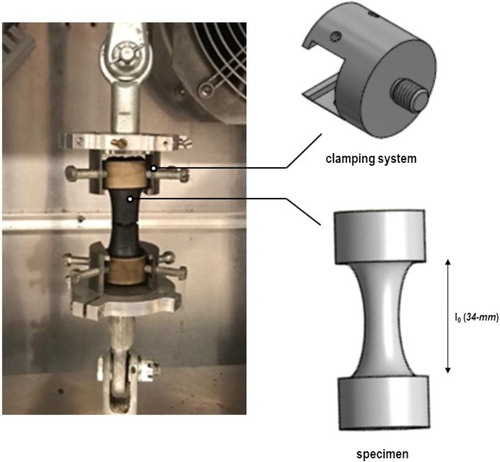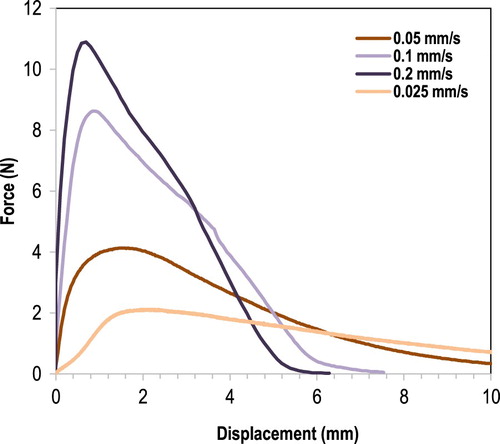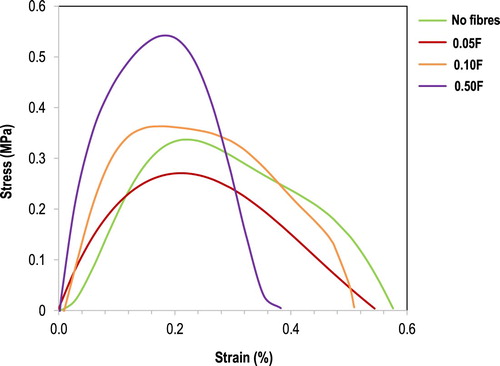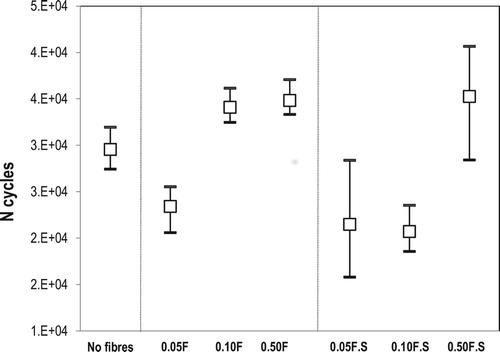Abstract
The utilisation of synthetic fibres has been reported in the past showing enhancement of fatigue and thermal cracking resistance in asphaltic materials. However, the limited evidences about the benefits of these fibres in asphaltic materials at low material scales have been noticed. Also, the exact reinforcing mechanism of binding system in the asphalt pavement mixes is still unclear. Therefore, this research examined experimentally the fracture performance of the synthetic reinforced asphalt mixes at the mortar level by using specially designed tools. Samples of three different fibre contents and two fibre lengths were evaluated. Pull-out tests, whose objective was to explore the potential interaction of fibre-matrix, demonstrated a matrix-type of fracture. Moreover, direct tension tests were carried out with both monotonic and cyclic loading to assess the effect of the synthetic fibres on tensile strength, fracture energy and ductility; and fatigue life of reinforced mixes. Improvements on mechanical characteristics of asphalt mortars have been observed when fibres were added. Also, the longer fibres of low dosages generated equivalent performance to the mix with the high dosages of shorter fibre. Hence, a potential initial cost reduction could be reached by means of utilising the longer synthetic fibres. Overall, the current results elucidated that implementing dedicated studies at various material levels can assist on understanding the material performance and on tailoring systems beyond sometimes the supplier-recommended additive dosages.
Introduction
An ever-increasing demand exists to produce durable asphaltic materials enabled to extend the lifetime of pavement structures to meet the continually increasing traffic loads. In combination with the unexpected climatic changes, performance-related problems, such as thermal cracking caused by the rapid temperature changes and low temperatures, are more obvious leading to increased maintenance costs. Within this framework, road authorities, pavement researchers and designers have been considering technologies to reduce these problems by delivering more durable materials (TRB Circular E-C165, Citation2012) and pavements (TRB Circular E-C186, Citation2014) of improved performance. Over the years, various technologies have been proposed to improve the performance of asphalt pavements, and one of these is the utilisation of fibres as reinforcement in asphaltic materials (NCHRP Synthesis Citation475, Citation2015). Reinforcing with fibres, and mainly synthetic fibres have been used widely in asphalt pavements (Edgar, Citation1998; Gibson et al., Citation2012; Gibson & Li, Citation2015; Guistozzi, Crispino, Toraldo, & Mariani, Citation2015; Ho, Shan, Wang, Chen, & Almonnieay, Citation2016; Kaloush, Biligiri, Zeiada, Rodezno, & Reed, Citation2010; McDaniel & Shah, Citation2003; Muftah, Bahadori, Bayomy, & Kassem, Citation2017; Prowell, Citation2000; Stempihar, Souliman, & Kaloush, Citation2012) because of the capacity of synthetic fibre-reinforced systems to withstand additional strain energy before cracking and to add extra tensile strength to the material. In other words, these systems are able to retard the deterioration progress of pavements.
Background
Initially, the utilisation of synthetic fibres was introduced for developing durable composite elements in the aerospace industry. Among others, aramid and polyolefin polymeric macromolecules have been used to form synthetic fibres. These fibres neither react with their surrounding matrix nor change its chemical properties. For this reason, a short description of the chemical and mechanical characteristics of aramid and polyolefin fibres, and previous applications of these fibres in pavement engineering are provided in the following sub-sections.
Characteristics of aramid and polyolefin fibres
The term aramid refers to a synthetic fibre, which is structured as a long-chain aromatic polyamide. The mechanical properties of aramid fibres are linked with the chemical structures generated during the manufacturing process of this fibre type. The condensation reaction between the monomers of 1,4-Para-Phenylenediamine (PPD) and Terephthaloyl Dichloride (TDC) form the polymer named Poly-Para-Phenylene terephthalamide (PPD-T), which is washed to remove the acidic substances after its production (Jassal & Ghosh, Citation2002). Once PPD-T is dried, it is extruded from a spinneret inside a strong acid. Most often sulphuric acid (>99.5%) is used as acid due to its high maximum solubility with PPD-T (Miracle and Donaldson, Citation2001), and thus the polymer rapidly coagulates and crystallises, forming its chemical structure. Afterwards, the fibre is rewashed to remove the acid in order to neutralise its pH. Then, the filament fibre is dried on steam-heated rolls, in a phase that the tensile strength and modulus is fully developed.
Looking at the chemical structure of PPD-T aramid fibre, the aromatic ring structure contributes to high thermal stability, while the para configuration contributes to the increase of modulus (Jassal & Ghosh, Citation2002). Aramid has higher mechanical properties than other polymer fibres while maintaining the same weight as glass or steel fibre, even at high temperatures, as its melting point is no less than 400°C. These enable a broad range of aramid fibre applications, particularly in hostile environments. In general, aramid fibres behave elastically when subjected to tension (van der Zwaag, Citation2009). However, different behaviour is shown under compression or bending, as plastic deformation occurs. This phenomenon is known to correspond to the formation of structural defects named as Kink bands related to compressive buckling of the aramid molecules. Therefore, the use of aramid as reinforcement in a compressive structure should be allowed only to a limited value.
Polyolefins consist of long and asymmetric chains (CH2 = CHx, x representing the alkyl group) composed of more than 85% by mass of ethane, propane or olefin units (Mather, Citation2009). There are two main synthetic components of polyolefins; polypropylene (PP) and polyethylene (PE). Generally speaking, polyolefin has excellent mechanical properties, such as high tensile strength and abrasion resistance, low specific gravity, non-water absorbent, and the ability to be thermally bonded. The PP yarns, which are the most dominant chemical component in polyolefin fibres, have excellent resistance to mineral acids and alkali as well as high shear strength, bulk elasticity and dimensional stability.
Characteristics of synthetic fibre reinforced asphaltic materials
The addition of synthetic fibres in asphalt and pavement structures as the reinforcing system has been applied successfully in the last decades and various applications exist (NCHRP Synthesis Citation475, Citation2015). For instance, polypropylene-aramid fibre-reinforced asphalt concrete mixes demonstrated improved performance in terms of permanent deformation (at high temperatures), fatigue and thermal cracking (at low temperatures) relative to a control mix (Kaloush et al., Citation2010). In another laboratory study, one polymer-modified and one synthetic fibre-reinforced asphalt concrete mix were evaluated in terms of cracking resistance (Gibson & Li, Citation2015). The dynamic modulus of the polymer-modified mix was higher than that of fibre reinforced in monotonic direct tension tests. The effect of fibres was more obvious under the cyclic tension loading in which the reinforced mix performed better at higher fatigue strains than the polymer-modified one (Gibson & Li, Citation2015). In the above cases, the design procedure for fibre-reinforced asphalt concrete mixes was the same as for conventional mixes.
A field study of two fibre-reinforced sections evaluated combinations of different modifiers, polyester and polypropylene reinforcements demonstrating the same rutting, fatigue cracking and ravelling performance for both control and reinforced mixes (Edgar, Citation1998). Another field study of different additives (i.e. polymer modifiers and synthetic fibres) in base, intermediate and surface mixes were investigated showing that the polyester fibre section was of the highest resistant against longitudinal and transverse cracking (McDaniel & Shah, Citation2003). No rutting or cracking distresses were reported as well in a section developed with polypropylene-polyester fibres demanding higher binder content (Prowell, Citation2000). Similarly, two independent field studies have demonstrated that the synthetic fibre reinforced mixes had improved thermal cracking and permanent deformation resistance (Guistozzi et al., Citation2015; Ho et al., Citation2016).
Additionally, a research investigated a polyester fibre reinforced asphalt mix in accelerated loading facility with the results to show remarkably better fatigue cracking resistance for the reinforced section than that of the polymer-modified (Gibson et al., Citation2012). Similar study using the same type of synthetic fibres concentrated on comparing the result of three different mixes: the field samples with fibre (0.5 kg/ton) from Jackson Hole Airport, without fibre from Sheridan County Airport, and one lab-designed mix without fibre (Stempihar et al., Citation2012). Finally, it has been observed that the synthetic fibres started to absorb strain energy and to reduce the crack propagation when the crack began to propagate at intermediate and high temperatures (Muftah et al., Citation2017). At lower temperatures, no improvement in terms of fracture energy was demonstrated between the control and the reinforced mixes. In the same study (Muftah et al., Citation2017), the bonding between the asphaltic matrix and the reinforcement was assessed as the weak point that should need further improvements for the whole system to resist fracture distresses sufficiently.
Motivation and objectives
Inconsistent results about the benefits of synthetic fibres in the reinforced system have been noticed and the exact reinforcing mechanism of the binding part in pavement structures is still unclear. Some types of fibres improved the material fracture performance at low temperature. Additionally, the mechanical response of reinforced composite materials, as the asphalt mixes, depends on three sets of parameters; (i) fibre (i.e. size, module, strength, volume content, shape and orientation), (ii) matrix (i.e. modulus, strength and fracture energy), and (iii) fibre-matrix bond interface parameters (i.e. bond strength and modulus, de-bonding energy). In this research, emphasis was given to examine the material at the mortar level (normal mix without coarse aggregates) using a synthetic fibre system to draw conclusions about the fibre-mortar bond interface performance and the uniaxial response in tension of synthetic fibre reinforced mortar systems. Finally, taking into account the great importance to lower the mix production temperature and thus to reduce emissions fumes and odours generated at the plant operations, fibre-reinforced asphalt mortar samples produced at condition similarly as producing warm-mix asphalt (WMA) mixes are investigated herein.
Materials and methods
Materials and sample preparation
Asphalt mortar samples with a fixed ratio by volume fraction of sand (0.47), filler (0.23) and bitumen of 50/70 pen-grad (0.30) were prepared in the laboratory. The ratio by weight of synthetic fibres between aramid (1.44 g/cm3) and polyolefin (0.9 g/cm3) fibres was 12.5:87.5, as supplied by the manufacturer. The mineral particles (i.e. sand and filler) and asphalt binder including a liquid warm additive (Anova 1502, 0.7% of binder weight) were pre-heated separately at 130°C and then mixed together at this temperature producing the asphalt mortar.
For the preparation of samples for pull-out testing, synthetic fibre strands of 0.053 grams were formed. The strands were placed after pouring the mortar into a split silicone mould on one side while one fibre strand had to be laid on top of it. Then mortar was poured to fulfil the rest of the total mould. This method was chosen due to its simplicity to keep the fibre placed in the centre and to ensure the interface length inside the samples. The split mould had a cylindrical shape with steel rings placed on top and bottom of the mould, Figure (a). The samples were then kept at the cooling chamber until the test was ready to be performed.
Figure 1. Pullout testing configurations: (a) split-up mould with steel ring (left) and the specimen in the mould, ready to be de-moulded (right), (b) clamping system of top fixture (top) and schematic of it (bottom), and (c) pullout testing setup.
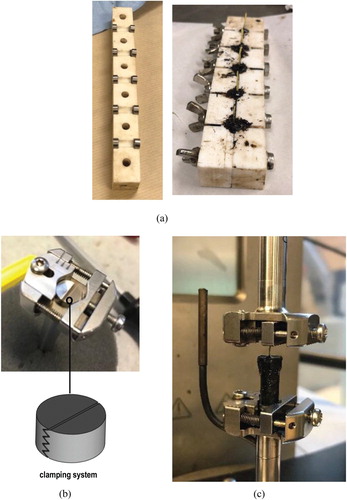
In case of preparing the dog-bone like samples for the direct uniaxial tensile tests, the asphalt mortar was mixed with different amount of fibres for approximately 5 min. The newly developed reinforced mix was placed back in the oven for a couple of minutes to reheat it along with the dog-bone mould to maintain mix workability. The mix was poured to the mould, and it was stored at a climate chamber and then a freezer until the specimens inside to be able to be de-attached without being prone to damage or deformation. For each test, three samples were prepared and tested.
Pull-out testing
The interface behaviour between metallic and synthetic fibres in asphalt mixes was investigated in the past, and it has been observed that aramid fibres had 5–7 times more pull-out strength than that of polyester fibres (Park, El-Tawil, & Naaman, Citation2017; Qian, Ma, & Feng, Citation2014). Nevertheless, the interaction between asphalt mortar and synthetic fibres was never examined and thus, in this research, a pull-out testing setup was developed, shown in Figure (b), to explore the bonding behaviour of synthetic fibre-asphalt mortar system.
The pull-out tests were performed using a dynamic shear rheometer (DSR) with a maximum loading capacity of 70 N, and the generated results were in the form of force against time or displacement. The effect of different temperatures was not taken into account due to a limitation in the clamping force, and thus the influence of different loading speed (i.e. 0.025, 0.05, 0.1 and 0.2 mm/s) was assessed at room temperature. The maximum load was obtained from the load-displacement curve at the peak point of the load, and the effect of various displacement rates on maximum load was evaluated. The pull-out test has been done to define the fibre-mortar friction and subsequently the bonding of fibre into the host structure.
Herein, the interpretation of interface failure mode was conducted considering three types of interfacial damage that can be generated with the pull-out testing (Park et al., Citation2017): (i) Matrix Failure (MatF), which resulted when the asphaltic matrix is pulled-out along with the fibre, mostly seen at high temperature and/or slow loading speed, (ii) Interface Failure (IntF); when caused when the fibre is pulled-out cleanly from the matrix (at low temperature and/or high loading speed), and (iii) Mix Failure (MixF) mode is the combination of the first and second mode which occurs most frequently. MatF is characterised by a slow and gradual increase in the force after the peak while IntF exhibits sudden drop after the peak.
Direct tensile testing
The current standardised test on tension capacity of an asphalt mix is performed as an indirect tension test with a cylindrical shape sample (ASTM D6931). The compression load creates tension stress at the centre part of the specimen causing the fracture. Alternatively, the tensile capacity of asphalt mixes can be measured with uniaxial tension tests in a more accurate manner. A method was proposed initially to perform direct tension tests of a specimen of dog-bone geometry (Erkens, Citation2002). The purpose of such geometry was to localise the failure to occur mainly in the centre part of the specimen. However, examinations in direct tensile test in asphalt concrete mixes did not show promising results, mainly due to the failure location occurred mainly near the top cap. Later on, a similar testing geometry of parabolic shape of different height was developed to examine the fatigue resistance of asphalt mortar (Apostolidis, Liu, Scarpas, Kasbergen, & van de Ven, Citation2016). The primary goal was to achieve a better stress distribution around the height of sample and to avoid the failure near the end cap. Herein, the specimen was formed in the dog-bone shape using the same parabolic shape as (Apostolidis et al., Citation2016) with a slight modification on the diameter of the centre to accompany the type of long fibres inside the mortar.
The uniaxial tension tests of dog-bone like specimens, as shown in Figure were performed at three different temperatures (−5°C, 5°C and 20°C) and a displacement rate of 0.1 mm/s, taking into account three different fibre contents (0.05%, 0.10% and 0.50%) and two fibre lengths (38-mm and 19-mm). For the monotonic testing analyses, due to the fact that the equipment is capable of measuring only the displacement in one direction, the generated strain was assumed to be homogeneous, uniaxial, and the Poisson effect was neglected. In the present study, the ductility was defined as the ability of a material to deform counted from the yielding point to the failure, while the energy was obtained by means of the total area under the stress–strain curve. Moreover, for the cyclic loading tests, they were carried at 5°C with loading frequency of 5 Hz, and the load level was determined by 35% of the peak load of the weakest samples of all monotonic testing scenarios. The goal was to observe the influence of the fibre on the fatigue life of asphaltic mortar, which was determined as the maximum number of cycles in which the sample failed.
Results and discussion
Pull-out testing
As shown in Figure , the pull-out tested samples exhibited a reduction of peak applied tensile load when the pull-out speed (displacement rate) was increased at high temperature. For the fibre-asphalt mortar systems, the mortar part (i.e. host structure) is characterised as a soft matrix due to the viscous dominant behaviour of asphaltic material at this temperature. The mutual compatibility of two soft phases was enhanced and the matrix-type cohesive failure caused. It is believed that the inclusion of polyolefin fibres in the strand of synthetic fibre assisted on generating bonding at the interface between fibre and mortar increasing, hence, the shear bond energy needed to result in interfacial fracture.
Initially, the interfacial bonding was improved and activation of the asphaltic matrix was observed while the fibre was pulled-out, since the residue of the mortar was brought causing the cohesive or matrix fracture to the sample (displacement rate of 0.025 mm/s). Considering that the testing method and extracted information to describe the contribution of the fibre could be improved by increasing the loading speed or by performing the test at a very low temperature, the pull-out speed was increased. A failure much closer to interface failure (IntF) mode was achieved resulting a more obvious activation of the fibre-matrix interface.
The interfacial characteristics of the synthetic fibre-asphalt mortar system were examined by performing the same test at higher displacement rates keeping the same testing temperature. It was observed that a higher loading speed resulted in a more rapid drop of the force after its peak value implying the tendency to generate an interface-type failure mode (IntF). The phenomenon is illustrated in Figure , where the applied load versus displacement is given for the pull-out testing samples. The samples tested at higher displacement rates (0.1 and 0.2 mm/s) exhibited a failure mode between IntF and MatF. Nonetheless, in Figure , the effect of different displacement rates is not visible to the total elongation except at the lowest displacement rate (0.025 mm/s). The calculation of effective perimeter and subsequently the shear stress generated through the pull-out test was also complicated.
Direct tensile testing
Beyond the fibre- asphaltic material interfacial bond performance, studies on reinforced systems in which fibres have formed a three-dimensional network were performed and the typical monotonic tensile stress versus tensile strain results are illustrated in Figure . The highest tensile stress value is obtained by the mortar with the highest amount of fibres in its structure, see Figure . The reinforcement with synthetic fibres leads to improved low-temperature cracking characteristics under monotonic fracture conditions. When 0.10% wt of fibres were added to mortar (0.10F), significant improvement was achieved at the lowest temperature (−5°C). Another remark is that the different amount of fibres does not give a dramatic impact at the lowest temperature due to the fact that the stress is mainly carried by the already stiffened asphaltic matrix. In general, the strength increased with the addition of synthetic fibres into mortar, an observation also seen by incorporating another type of fibres in the past (Apostolidis et al., Citation2016).
Figure 5. Peak tensile stress results at: (a) −5°C, (b) 5°C, and (c) 20°C (F: long fibres, F.S: short fibres).

Since higher total energy means that the higher capacity of a material to absorb any applied energy until its failure point, the high energy values are desirable. In other words, the increase of energy required to cause failure to the material, such as tensile fracture, corresponds to the elongation under loading. From Figure , it can be concluded that the amount of fibre into a mix influences the energy needed to fracture under monotonic loads. However, such an interesting occurrence can be seen at the lower testing temperatures (i.e. −5°C and 5°C). The total energy does not differ for any given fibre content at the lowest temperature. This phenomenon corresponds to the tensile strength, in which the addition of fibre does not have a significant contribution to material properties. On the contrary, the energy level of 0.05% and 0.10% fibre samples are similar at 5°C, while the strength differs, indicating a deduction of a more ductile material once 0.05% amount of fibre was added. The addition of fibres into the mortar increased the cracking resistance manifested by greater elongation at failure.
Figure 6. Total dissipated energy results from monotonic loading direct tension tests at: (a) −5°C, (b) 5°C, and (c) 20°C (F: long fibres, F.S: short fibres).
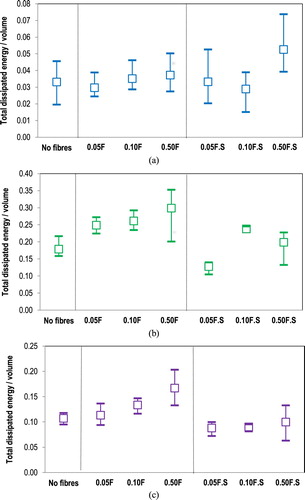
Figure illustrated that the addition of more fibres negatively influences the ductility, in which less ductility of the system leads to less energy dissipation by plastic deformation. Nevertheless, more phenomena can be observed herein as well to give an in-depth understanding of reinforcing mechanisms and the influence of synthetic fibres into the asphaltic matrix. Firstly, the addition of 0.05% fibre content (0.05F) increases the ductility of mortar by almost half of the control mix at a lower temperature. This is possible as the fibre contribution can be activated after the sample has been pulled out for some time. On the other hand, the control mix had the highest ductility at 20°C mainly due to the fact that the significant part which contributes to the ductility might be the asphaltic matrix. Further, it is clear that the mix with 0.50% fibre content (0.50F) has half of the ductility of the 0.05F on both temperatures. The addition of 0.50% fibres will actually remove part of the other asphalt constituents that sit next to it while it is being stretched, therefore cracks could be initiated damaging the material.
Figure 7. Ductility results from monotonic loading direct tension tests at: (a) 5°C, and (b) 20°C (F: long fibres, F.S: short fibres).
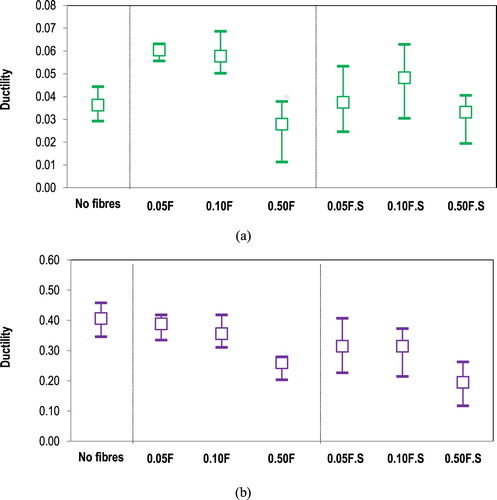
The same trend can be depicted furthermore from the graphs for the shorter fibres, with only slight differences between the longer and shorter fibres in terms of peak stress and ductility at a higher temperature in particular. This implies that the difference in fibre length is not significant at a higher temperature. A further distinction can be developed between the longer and shorter fibre. As previously discussed, while the trends are highly similar, it is still noticeable that the behaviour shown by the mix with the dosage of 0.10% of longer fibre is somehow comparable to that of 0.50% of the short fibre in almost every test conditions, except at the lowest temperature. The performance of the specimens with the short fibres at the lowest temperature is higher in each aspect, regardless of the dosage of the fibre.
Cyclic uniaxial tension tests were conducted to estimate the fatigue life of the reinforced asphaltic system, and specifically to identify the effect of the fibres added into the mix. The results from these fatigue tests are illustrated in Figure . Evidently, the highest fibre content does not provide a significant contribution to the extension of fatigue life, as its performance was close to the samples of 0.10% fibre content (0.10F), with the dosage of 0.05% (0.05F) had the lowest fatigue life among the tested recipes. A contrasting conclusion is drawn for the shorter fibre. While the amount of the fibre remains proportionally related to the fatigue life, the dosage of 0.10% behaves similarly to the dosage 0.05% with a high increment is exhibited by mortar mix with the dosage of 0.50%. It can be concluded then that a high dosage of short fibre is necessary to improve the fatigue life of a mix, while the use of the longer fibre could minimise the demand up to only 20% of the dosage of shorter fibres with an almost identical performance.
Conclusions
The interface failure of fibre-asphaltic materials regularly occurred as the consequence of weak bonding between the host structure and the added phase, in this case, the synthetic fibres. Herein, the interaction of fibre-matrix was assessed by performing pull-out tests at test temperature showing a cohesive or a matrix-type of fracture (MatF). Nevertheless, it is clearly seen that a significantly high pull-out loading speed is almost able to generate a higher peak force and rapid drop after the yielding point, at the same testing temperature. Moreover, a difficulty to reach the IntF mode was demonstrated, and therefore further studies should emphasise more on higher loading speeds (or lower temperatures) to study more about the interfacial interaction of fibre-reinforced asphaltic systems.
Testing under the uniaxial tension having dog-bone shape samples of fibre reinforced mixes, it is possible to localise the fracture at the middle of sample demonstrating clearly the effect of synthetic fibres on the fracture performance of mortar. The reinforcing effect of fibres of different characteristics was evident in the current research.
Under monotonic tension, the effect on tensile strength of fibre reinforced asphalt mortar was not significant at low temperature and still directly proportional to the fibre dosage within the matrix. The use of shorter fibre created the same trend generating a more dramatic improvement using a lower fibre dosage. However, any dosage of shorter fibre resulted in similar impact. Furthermore, the variation of total energy is mostly influenced by the applied load at low temperature. The total amount of dissipated energy means the total energy needed to damage the sample, and hence a higher amount of energy is preferred to develop durable asphaltic materials. Meanwhile, the ductility plays a more dominant role at higher temperatures, in which the increase fibre dosage resulted in a decrease of ductility. In general, the result of the longer fibre is somewhat comparable to that of the shorter ones, a trend which can be explained as the presence of fibre inside the mix removed the other material while being stretched, causing the damage from inside. Additionally, it was found that the dosage increase is able to extend fatigue life under cyclic uniaxial tension.
Both monotonic and cyclic uniaxial tension tests conclude that the addition of the longer fibre with the dosage of 0.10% wt generates an equivalent performance to the mix with the dosage of 0.50% of shorter fibre. Therefore, it is presumed that the longer synthetic fibres could assist on reducing the initial cost of utilising high dosages of fibres for reinforcing the asphaltic materials since equivalent performance can be reached when the application conditions demand the addition of fibres.
Finally, it is believed that the inclusion of polyolefin fibres in the strand of synthetic fibre helped on generating interfacial bonding between fibre and mortar increases and, hence, the de-bonding energy needed to result interfacial fracture. The incorporation of adhesion promoters to enhance the bonding characteristics is an option for future research work to optimise and tailor reinforced paving materials. Further, the fibre-binder interface should be studied in-depth since the latter affects the compatibility of the reinforced system in which the incorporation of synthetic fibres, as shown from the uniaxial tension tests, influence the stress distribution and the fracture propagation in reinforced asphaltic materials. Beyond the synthetic fibres, evolutionary developments in bio-inspired (e.g. bone and nacre) and nature oriented synthetic fibres (e.g. cellulose fibres) added of a small volume fraction could result in reinforced systems with remarkable structural properties.
ORCID
Panos Apostolidis http://orcid.org/0000-0001-5635-4391
Sandra Erkens http://orcid.org/0000-0002-2465-7643
References
- Apostolidis, P., Liu, X., Scarpas, A., Kasbergen, C., & van de Ven, M. (2016). Advanced evaluation of asphalt mortar for induction healing purposes. Construction and Building Materials, 126, 9–25. doi: 10.1016/j.conbuildmat.2016.09.011
- Edgar, R. (1998). Ten year performance of asphalt additive test section Lava Butte–Fremont highway junction section. Final report. FHWA-ORRD- 99-08. Salem: Oregon Department of Transportation.
- Erkens, S. (2002). Asphalt concrete response (ACRs): Determination, modeling and prediction (PhD Thesis). Delft University of Technology.
- Gibson, N., & Li, X. (2015). Characterizing cracking of asphalt mixtures with fibre reinforcement: Use of cyclic fatigue and direct tension strength tests. Transportation Research Record: Journal of the Transportation Research Board, 2507, 57–66. doi: 10.3141/2507-07
- Gibson, N., Qi, X., Shenoy, A., Al-Khateeb, G., Kutay, E., Andriescu, A., … Harman, T. (2012). Performance testing for superpave and structural validation. Report FHWA-HRT-11-045. McLean, VA: Federal Highway Administration, U.S. Department of Transportation.
- Guistozzi, F., Crispino, M., Toraldo, E., & Mariani, E. (2015). Mix design of polymer-modified and fibre-reinforced warm-mix asphalts with high amount of reclaimed asphalt pavement: Achieving sustainable and high-performing pavements. In Transportation Research Record: Journal of the Transportation Research Board, no. 2523 (pp. 3–10). Washington, DC: Transportation Research Board of National Academies.
- Ho, C., Shan, J., Wang, F., Chen, Y., & Almonnieay, A. (2016). Performance of fibre-reinforced polymer modified asphalt: Two-year review in Northern Arizona. In Transportation Research Record: Journal of the Transportation Research Board, no. 2575 (pp. 138–149). Washington, DC: Transportation Research Board of National Academies.
- Jassal, M., & Ghosh, S. (2002). Aramid fibres-an overview. Indian Journal of Fibre and Textile Research, 27(3), 290–306.
- Kaloush, K. E., Biligiri, K. P., Zeiada, W. A., Rodezno, M. C., & Reed, J. X. (2010). Evaluation of fibre-reinforced asphalt mixtures using advanced material characterization tests. Journal of Testing and Evaluation, 38(4), 1–12.
- Mather, R. (2009). The structure of polyolefin fibres. In S.J. Eichhorn, J.W.S. Hearle, M. Jaffe, & T. Kikutani (Eds.), Handbook of textile fibre structure - Volume 1: Fundamentals and manufactured polymer fibres (pp. 276–304). Cambridge: Woodhead Publishing Series in Textiles.
- McDaniel, R., & Shah, A. (2003). Asphalt additives to control rutting and cracking. Report FHWA/IN/JTRP-2002/29. West Lafayette, IN: Purdue University.
- Miracle, D.B., & Donaldson, R.L. (2001). ASM Handbook Volume 21, Composites. Materials Park, OH: ASM International.
- Muftah, A., Bahadori, A., Bayomy, F., & Kassem, E. (2017). Fibre-reinforced hot-mix asphalt: Idaho case study. In Transportation Research Record: Journal of the Transportation Research Board, no. 2633 (pp. 98–107). Washington, DC: Transportation Research Board of National Academies.
- NCHRP Synthesis 475. (2015). Fiber additives in asphalt mixtures. Washington, DC: Transportation Research Board of the National Academies.
- Park, P., El-Tawil, S., & Naaman, A. (2017). Pull-out behavior of straight steel fibers from asphalt binder. Construction and Building Materials, 144, 125–137. doi: 10.1016/j.conbuildmat.2017.03.159
- Prowell, D. B. (2000). Design, construction, and early performance of hot- mix asphalt stabilizer and modifier test sections. Interim report. VTRC 00-IR2. Charlottesville: Virginia Transportation Research Council.
- Qian, S., Ma, H., & Feng, J. (2014). Fiber reinforcing effect on asphalt binder under low temperature. Construction and Building Materials, 61, 120–124. doi: 10.1016/j.conbuildmat.2014.02.035
- Stempihar, J., Souliman, M., & Kaloush, K. (2012). Fibre-reinforced asphalt concrete as sustainable paving material for airfields. In Transportation Research Record: Journal of the Transportation Research Board, no. 2266 (pp. 60–68). Washington, DC: Transportation Research Board of National Academies.
- TRB Circular E-C165. (2012). Alternative binders for sustainable asphalt pavements. Washington, DC: Transportation Research Board of the National Academies.
- TRB Circular E-C186. (2014). Enhancing durability of asphalt pavements. Washington, DC: Transportation Research Board of the National Academies.
- van der Zwaag, S. (2009). Structure and properties of aramid fibres. In S.J. Eichhorn, J.W.S. Hearle, M. Jaffe, & T. Kikutani (Eds.), Handbook of textile fibre structure - Volume 1: Fundamentals and manufactured polymer fibres (Vol. 1, pp. 394–412). Cambridge: Woodhead Publishing Series in Textiles.

